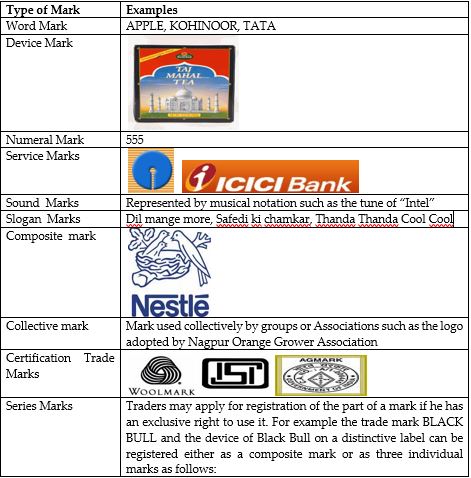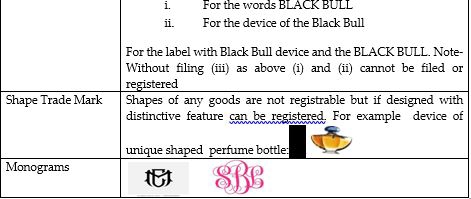What is a Trade Mark?
A Trade Mark (popularly known as brand name) is a visual symbol which may be a word, signature, name, device, label, numerals or combination of colours used by a proprietor on his/ her goods or services to distinguish it from other similar goods or services originating from a different undertaking/ proprietor. A Trade Mark means a mark capable of being represented graphically and which is capable of distinguishing the goods or services of one person from those of others
Various Types of Trade Marks
Who can apply for a Trade Mark? What are the requirements to be fulfilled while applying for a trade mark registration?
Any person claiming to be the proprietor of a Trade Mark used or proposed to be used by him/ her may apply in writing in prescribed manner for registration. The application should contain the Trade Mark, goods or services, name and address of applicant and agent (if any) with power of attorney, statement to use of the mark, documentary proof of use and signature. The application should be in English or Hindi. It should be filed at the appropriate office of the Trade Marks Registry. The legal requirements for registration of Trade Marks under Indian Trade Marks Act are as follows:
- The selected mark should be capable of being represented graphically (that is in the paper form);
- It should be capable of distinguishing the goods or services of one undertaking from those of others;
- It should be used or proposed to be used mark in relation to goods or services for the purpose of indicating or so as to indicate a connection in the course of trade between the goods or services and some person have the right to use the mark with or without identity of that person
Can unregistered trade marks be protected in India?
Yes, unregistered trade marks can be protected under common law rights and law of passing off.
What should one take into consideration while selecting a trade mark?
One must ensure the following while choosing a trade mark:
- If it is a word it should be easy to speak, spell, and remember. Example: SONY, TATA
- The best of trade marks are invented words or coined words. Example: KODAK, DALDA.
- The trade mark should not be Geographical name.
- Avoid adopting laudatory word or words that describe the quality of goods and services, such as BEST, PERFECT, SUPER, QUALITY.
Whether well-known trade marks can be protected under Indian Trade Mark Act?
Yes. Well known trade marks even for unrelated goods and services can be protected, some examples are as follows
What is the procedure for registration of a trade mark and how much time is generally required for a mark to be registered?
The step-wise process for registration of a trade mark is as follow:
- Application for Registration
- Examination of Application
- Hearing
- Acceptance of Applications
- Publication of Trade mark Application in Journal
- Wait for four months, if no opposition filed proceed to registration
- Opposition Proceedings.
- Registration of Trade Marks
- Renewal of Trade Marks
- Post Registration
The time from filing of application for trademark registration to registration in case no opposition is filed would generally take 18 months and in case the mark is opposed, the time for registration would normally takes 2 to 3 years.
What system is followed for classifying goods/ services, and how does this system differ from the International Classification System for goods and services? Are multi-class applications available and what are the estimated cost savings?
India is a signatory of Nice Classification of Goods And Services and the classification is determined in accordance with this classification. However, in terms of Section 7 of Trade Marks Act, 1999, the Registrar shall classify the goods/ services which also include Indian goods/ services generally not found in the International classification of goods and services. For example Indian variety of food items and traditional dresses are not included in nice classification but classified in the list published by Registrar of Trade Marks. Such classification by the Registrar of Trade Marks are being updated time to time and hosted on official website of the Registry.
What objections are generally raised by Examiners while examining the Applications? Whether consent letter is acceptable?
An objection will be raised if the mark:
- contains descriptive words or device;
- contains words or expressions prohibited under Emblem and Names Act, 1950;
- contains obscene and scandalous matter;
- contains International non proprietary names;
- likely to deceive or cause confusion;
- contain word having geographical significance;
- is substantially identical or deceptively similar to a trademark that is the subject of an earlier application or registration and that covers identical or similar goods or services.
Applicants are given 30 days’ time to reply to the objections raised in the examination report. Consent obtained under Section 11(4) from proprietor of earlier trade mark is acceptable by Registrar of Trade Marks
Whether there are any provisions of appeal in Indian Trade Marks Act in case application is refused?
Yes, in the first instance the applicant can file a review petition before the refusing Authority that is Registrar of Trade Marks and in the event of non-consideration of the review petition, the applicant can file an appeal before Intellectual Property Appellate Tribunal (IPAB). The applicant may directly file appeal before IPAB without availing the option of the review of decision.
What are the benefits of registration?
- Confers exclusive right to the owner
- Can take infringement action against Unauthorized user
- Registered Trade Marks can be assigned
- The mark can be allowed to use under license agreement
- Generates income through licensing, sale or commercialisation.
- Improves organisation market share.
- Raise profit margin
- Increases the worth of the organization in the eyes of investors and financial institution.
- Provides competitive value in the event of sale, merger, acquisition
What symbols and letters are to be used to depict that a trademark application has been filed or that a trade mark is already registered?
Proprietors of registered trade marks can use the symbol ® on their trade marks and an applicant whose application for registration is pending before Registrar of Trade Marks can use symbol
How long does a registration remain in effect and what is required to maintain a registration? Is proof of use to be submitted?
The term of registration is 10 years calculated from the filing date, extendible by further periods of 10 years by filing application for renewal of trade mark failing which mark will be removed from the register of trade marks. There is no requirement to file proof of use of a mark to maintain the registration, unless a third party applies through rectification petition to remove the registration on grounds of non-use





